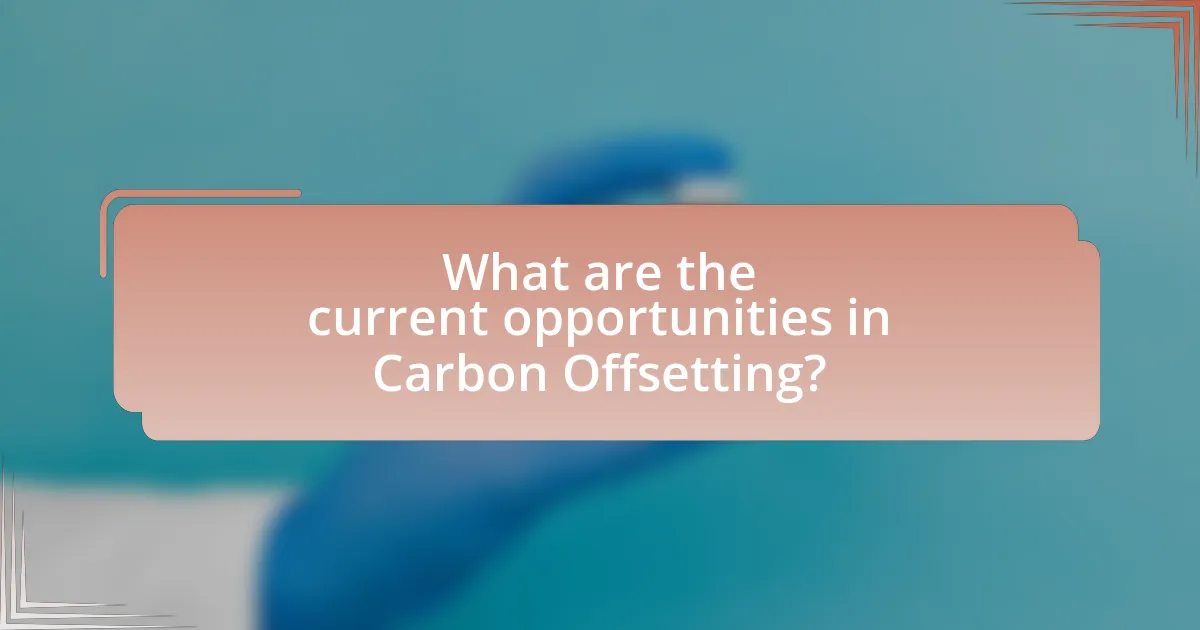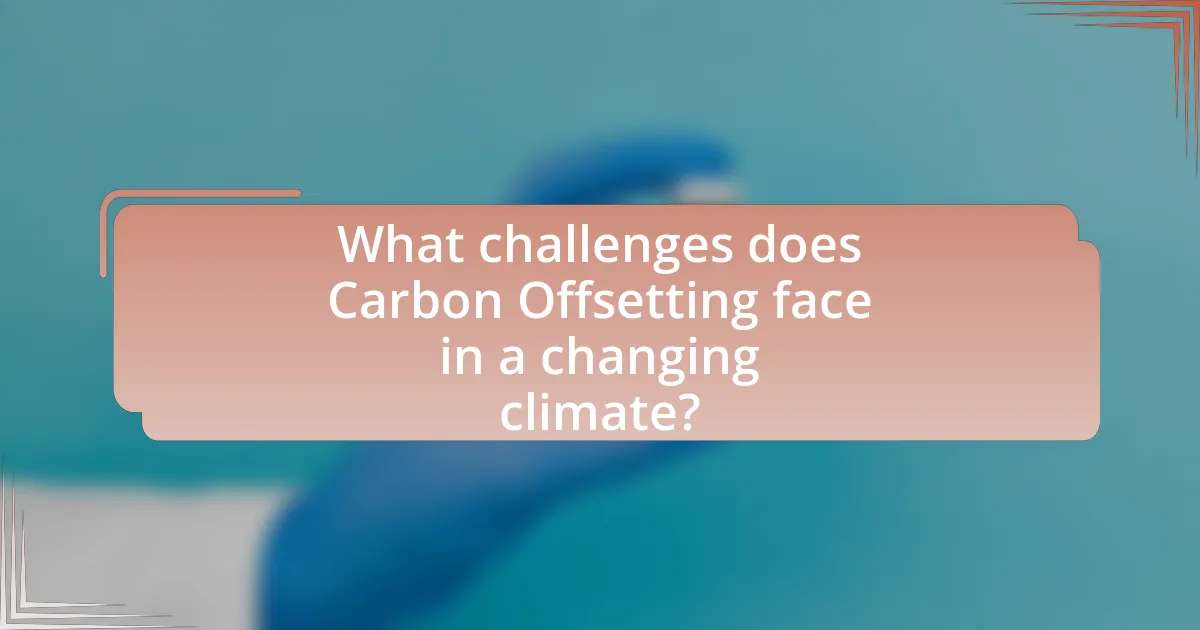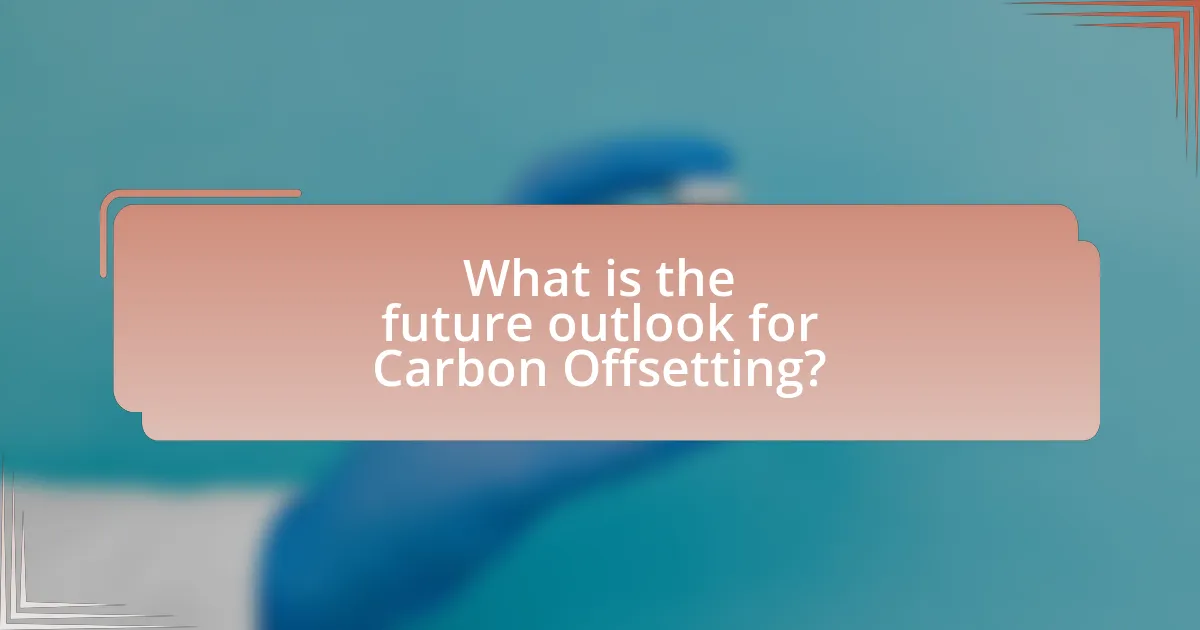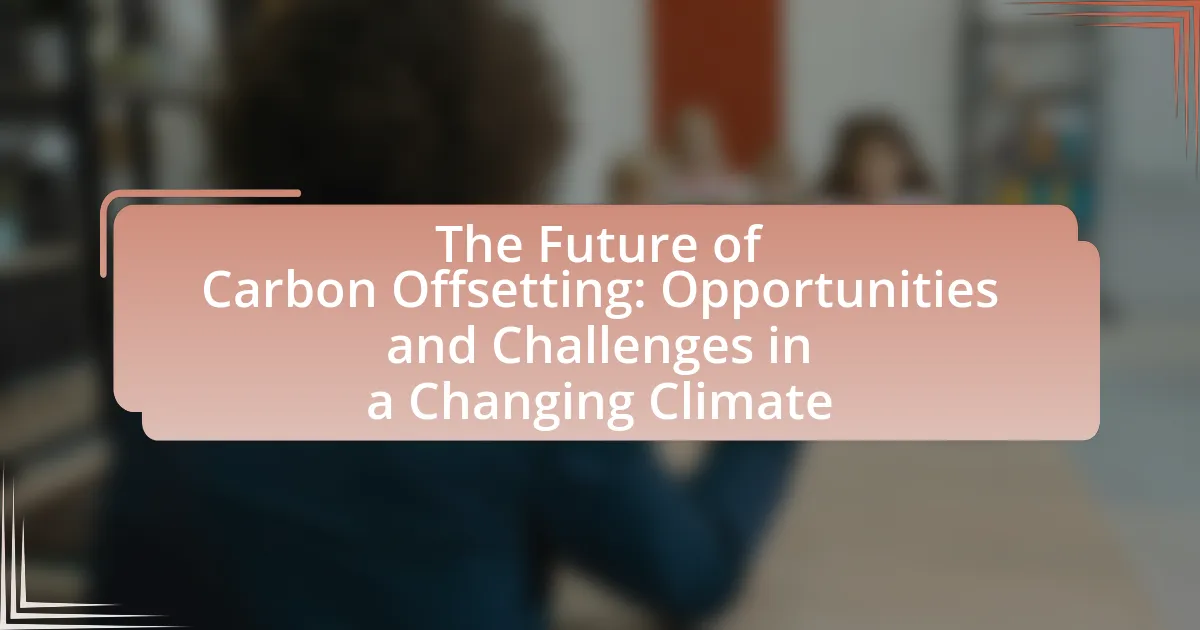The article focuses on carbon offsetting, a mechanism that allows individuals and organizations to compensate for their greenhouse gas emissions by investing in projects that reduce or remove an equivalent amount of carbon dioxide from the atmosphere. It explores how carbon offsetting works, the key mechanisms involved, and its importance in addressing climate change and achieving global sustainability goals. Additionally, the article discusses current opportunities in carbon offsetting, the role of innovative technologies, challenges faced in a changing climate, criticisms of the practice, and best practices for organizations to enhance the credibility and effectiveness of their offsetting efforts. The future outlook for carbon offsetting is also examined, highlighting market dynamics and the influence of international agreements on its evolution.

What is Carbon Offsetting?
Carbon offsetting is a mechanism that allows individuals and organizations to compensate for their greenhouse gas emissions by investing in projects that reduce or remove an equivalent amount of carbon dioxide from the atmosphere. This practice often involves purchasing carbon credits, which represent a reduction of one metric ton of carbon dioxide emissions, achieved through initiatives such as reforestation, renewable energy projects, or energy efficiency improvements. According to the International Carbon Reduction and Offset Alliance, carbon offsetting plays a crucial role in achieving global climate goals by enabling entities to take responsibility for their emissions while supporting sustainable development initiatives.
How does Carbon Offsetting work?
Carbon offsetting works by compensating for carbon dioxide emissions produced by an individual or organization through investments in projects that reduce or remove an equivalent amount of carbon from the atmosphere. These projects can include reforestation, renewable energy initiatives, and energy efficiency improvements. For instance, the purchase of carbon credits from a wind farm can offset emissions from fossil fuel use, as each credit represents a specific amount of carbon dioxide reduced or avoided. According to the International Carbon Reduction and Offset Alliance, effective carbon offsetting can lead to significant reductions in greenhouse gas emissions, contributing to climate change mitigation efforts.
What are the key mechanisms of Carbon Offsetting?
The key mechanisms of carbon offsetting include emissions reduction projects, carbon credits, and market-based trading systems. Emissions reduction projects, such as reforestation or renewable energy initiatives, actively decrease greenhouse gas emissions. Carbon credits represent a quantifiable reduction of one metric ton of CO2, allowing individuals or companies to purchase these credits to compensate for their emissions. Market-based trading systems, like cap-and-trade, enable businesses to buy and sell emissions allowances, creating a financial incentive to reduce overall emissions. These mechanisms collectively facilitate the transition to a low-carbon economy by promoting sustainable practices and investments in environmental projects.
How do carbon credits function within this system?
Carbon credits function as a market-based mechanism that allows entities to offset their greenhouse gas emissions by purchasing credits from projects that reduce or remove emissions elsewhere. Each carbon credit typically represents one metric ton of carbon dioxide equivalent (CO2e) reduced or sequestered, providing a quantifiable way for businesses and individuals to meet regulatory requirements or voluntary sustainability goals. The system operates on the principle of cap-and-trade, where a limit is set on total emissions, and companies can buy and sell credits, incentivizing reductions in emissions and promoting investment in cleaner technologies. This approach has been validated by various international agreements, such as the Kyoto Protocol, which established frameworks for carbon trading and demonstrated its effectiveness in reducing global emissions.
Why is Carbon Offsetting important in the context of climate change?
Carbon offsetting is important in the context of climate change because it provides a mechanism for individuals and organizations to compensate for their greenhouse gas emissions by funding projects that reduce or remove carbon dioxide from the atmosphere. This practice is essential as it helps to achieve net-zero emissions targets, which are critical for limiting global warming to 1.5 degrees Celsius, as outlined in the Paris Agreement. For instance, projects such as reforestation, renewable energy installations, and methane capture from landfills can effectively sequester carbon, thereby mitigating the impacts of climate change. According to the International Carbon Reduction and Offset Alliance, carbon offsetting can play a significant role in achieving climate goals by facilitating investments in sustainable practices and technologies.
What role does Carbon Offsetting play in reducing greenhouse gas emissions?
Carbon offsetting plays a crucial role in reducing greenhouse gas emissions by allowing individuals and organizations to compensate for their emissions through investments in projects that reduce or sequester carbon dioxide elsewhere. This mechanism enables the funding of renewable energy projects, reforestation, and energy efficiency initiatives, which collectively contribute to a net decrease in atmospheric carbon levels. For instance, the International Carbon Reduction and Offset Alliance reports that carbon offset projects can lead to significant reductions, with some projects achieving up to 1.1 billion tons of CO2 equivalent reductions annually. By facilitating a market for carbon credits, carbon offsetting encourages sustainable practices and drives investment in green technologies, ultimately supporting global efforts to mitigate climate change.
How does Carbon Offsetting contribute to global sustainability goals?
Carbon offsetting contributes to global sustainability goals by enabling individuals and organizations to compensate for their greenhouse gas emissions through investments in projects that reduce or sequester carbon dioxide. This mechanism supports initiatives such as reforestation, renewable energy development, and energy efficiency improvements, which collectively aim to mitigate climate change impacts. For instance, the International Carbon Reduction and Offset Alliance reports that carbon offset projects can lead to significant reductions in emissions, with some projects achieving reductions of over 1 million tons of CO2 annually. By facilitating financial support for these sustainable projects, carbon offsetting plays a crucial role in achieving targets set by international agreements like the Paris Agreement, which aims to limit global warming to well below 2 degrees Celsius.

What are the current opportunities in Carbon Offsetting?
Current opportunities in carbon offsetting include investments in renewable energy projects, reforestation initiatives, and advancements in carbon capture technology. The renewable energy sector is rapidly growing, with the International Renewable Energy Agency reporting that global renewable energy capacity reached 2,799 GW in 2020, creating significant potential for carbon offset projects. Reforestation efforts, supported by organizations like the United Nations, aim to restore ecosystems and sequester carbon, with the Bonn Challenge targeting the restoration of 150 million hectares of deforested land by 2020. Additionally, innovations in carbon capture and storage (CCS) are gaining traction, with the Global CCS Institute noting that there are over 26 commercial CCS facilities in operation worldwide, providing new avenues for offsetting emissions. These opportunities are crucial for meeting global climate goals and transitioning to a low-carbon economy.
How can businesses leverage Carbon Offsetting for competitive advantage?
Businesses can leverage carbon offsetting for competitive advantage by enhancing their brand reputation and attracting environmentally conscious consumers. By investing in carbon offset projects, such as reforestation or renewable energy initiatives, companies can demonstrate their commitment to sustainability, which can differentiate them in a crowded market. Research indicates that 66% of consumers are willing to pay more for sustainable brands, highlighting the financial benefits of adopting eco-friendly practices. Furthermore, businesses that actively engage in carbon offsetting can improve their compliance with regulatory requirements and reduce potential risks associated with climate change, thereby positioning themselves as leaders in corporate responsibility.
What are the financial benefits of investing in Carbon Offsetting?
Investing in carbon offsetting provides financial benefits such as cost savings, potential revenue generation, and enhanced brand value. Companies that invest in carbon offset projects can reduce their carbon footprint, which may lead to lower compliance costs with environmental regulations. For instance, businesses that proactively manage their emissions may avoid penalties and take advantage of tax incentives related to sustainability efforts. Additionally, carbon offsetting can create new revenue streams through the sale of carbon credits, which can be traded in various markets. A study by the International Carbon Action Partnership indicates that the global carbon market could reach a value of $50 billion by 2030, highlighting the financial opportunities available. Furthermore, companies that demonstrate commitment to sustainability often experience improved brand loyalty and customer retention, translating into increased sales and market share.
How can Carbon Offsetting enhance corporate social responsibility initiatives?
Carbon offsetting enhances corporate social responsibility (CSR) initiatives by allowing companies to mitigate their environmental impact through investments in projects that reduce greenhouse gas emissions. This practice not only demonstrates a commitment to sustainability but also aligns corporate values with societal expectations, thereby improving brand reputation and customer loyalty. For instance, a study by the Carbon Trust found that 72% of consumers are more likely to purchase from companies that actively engage in carbon offsetting. By integrating carbon offsetting into their CSR strategies, businesses can effectively contribute to climate change solutions while fulfilling their ethical obligations to stakeholders.
What innovative technologies are emerging in the Carbon Offsetting space?
Innovative technologies emerging in the carbon offsetting space include blockchain for transparent tracking of carbon credits, artificial intelligence for optimizing carbon capture processes, and direct air capture systems that remove CO2 from the atmosphere. Blockchain technology enhances accountability and traceability in carbon credit transactions, as evidenced by projects like Climate Ledger Initiative, which aims to create a decentralized platform for carbon markets. Artificial intelligence is being utilized to improve efficiency in carbon capture and storage, with companies like Carbon Clean Solutions leveraging machine learning to optimize their processes. Direct air capture technologies, such as those developed by Climeworks, are gaining traction, with the potential to remove millions of tons of CO2 annually, demonstrating their scalability and effectiveness in combating climate change.
How do blockchain and digital platforms improve transparency in Carbon Offsetting?
Blockchain and digital platforms enhance transparency in carbon offsetting by providing immutable records of transactions and real-time data sharing. These technologies enable stakeholders to track carbon credits from their origin to retirement, ensuring that each offset is legitimate and not double-counted. For instance, blockchain’s decentralized ledger allows for verification of carbon offset projects, making it easier to audit and validate claims. This transparency is crucial, as it builds trust among buyers, sellers, and regulatory bodies, ultimately leading to more effective carbon offset markets.
What role do reforestation and renewable energy projects play in Carbon Offsetting?
Reforestation and renewable energy projects are critical components of carbon offsetting as they actively reduce greenhouse gas emissions and enhance carbon sequestration. Reforestation involves planting trees that absorb carbon dioxide from the atmosphere, with studies indicating that one mature tree can absorb approximately 48 pounds of CO2 annually. Renewable energy projects, such as wind and solar, replace fossil fuel energy sources, thereby preventing the release of significant amounts of CO2; for instance, transitioning to wind energy can reduce carbon emissions by up to 90% compared to coal. Together, these initiatives not only mitigate climate change impacts but also contribute to sustainable development goals by promoting biodiversity and reducing reliance on non-renewable resources.

What challenges does Carbon Offsetting face in a changing climate?
Carbon offsetting faces significant challenges in a changing climate, primarily due to the increasing unpredictability of natural ecosystems and the effectiveness of offset projects. As climate change accelerates, extreme weather events, such as floods and droughts, can disrupt carbon sequestration efforts, rendering some projects ineffective. For instance, a study by the World Resources Institute highlights that forest fires, exacerbated by climate change, can release stored carbon back into the atmosphere, negating the benefits of reforestation initiatives. Additionally, the shifting climate can alter the viability of certain offset strategies, making it difficult to ensure long-term carbon storage. This unpredictability complicates the assessment of carbon credits and undermines the credibility of offsetting as a reliable climate solution.
What are the criticisms of Carbon Offsetting?
Criticisms of carbon offsetting include concerns about its effectiveness, potential for greenwashing, and lack of regulatory oversight. Many argue that carbon offsetting allows companies and individuals to continue polluting while merely paying for offsets, which may not result in actual emissions reductions. Research indicates that some offset projects do not deliver the promised environmental benefits, leading to skepticism about their credibility. Additionally, the absence of standardized metrics for measuring the impact of offsets can result in misleading claims, further complicating the integrity of carbon offsetting initiatives.
How do concerns about the effectiveness of Carbon Offsetting impact its adoption?
Concerns about the effectiveness of carbon offsetting significantly hinder its adoption. When stakeholders doubt the actual impact of offset projects on reducing carbon emissions, they become less likely to invest in or support these initiatives. For instance, studies indicate that many offset projects may not deliver the promised environmental benefits, leading to skepticism among businesses and consumers. This skepticism is further fueled by reports from organizations like the Carbon Market Watch, which highlight issues such as overestimation of emission reductions and lack of transparency in project implementation. Consequently, the perceived ineffectiveness of carbon offsetting can result in reduced participation and investment, ultimately slowing the transition to more sustainable practices.
What ethical considerations arise in the practice of Carbon Offsetting?
The ethical considerations in the practice of carbon offsetting include issues of equity, transparency, and effectiveness. Equity concerns arise when offsetting projects disproportionately benefit wealthier nations or individuals while neglecting vulnerable communities that are often most affected by climate change. Transparency is critical, as many offset programs lack clear reporting on how funds are used and the actual impact of projects, leading to skepticism about their effectiveness. Effectiveness is questioned when offsets do not result in real, additional, and permanent emissions reductions, potentially allowing polluters to continue harmful practices under the guise of offsetting. These considerations highlight the need for rigorous standards and accountability in carbon offsetting initiatives to ensure they contribute meaningfully to climate action.
How does regulatory uncertainty affect Carbon Offsetting initiatives?
Regulatory uncertainty negatively impacts carbon offsetting initiatives by creating an unpredictable environment for investment and project development. When regulations are unclear or frequently changing, businesses and investors may hesitate to commit resources to carbon offset projects, fearing that future policy shifts could undermine their viability or profitability. For instance, a study by the World Bank in 2020 indicated that regulatory clarity is essential for fostering a stable market for carbon credits, as it encourages long-term planning and investment. Without this clarity, the effectiveness and scalability of carbon offsetting initiatives are significantly hindered, limiting their potential to contribute to climate change mitigation efforts.
What are the implications of changing government policies on Carbon Offsetting?
Changing government policies on carbon offsetting can significantly impact the effectiveness and viability of carbon markets. For instance, stricter regulations may enhance the credibility of carbon credits, leading to increased investment in sustainable projects. Conversely, lenient policies could result in oversupply of credits, diminishing their value and undermining environmental goals. Historical examples, such as the European Union Emissions Trading System, illustrate that policy adjustments directly influence market dynamics, with tighter caps leading to higher carbon prices and greater emissions reductions.
How can businesses navigate the complexities of Carbon Offsetting regulations?
Businesses can navigate the complexities of Carbon Offsetting regulations by staying informed about current laws, engaging with regulatory bodies, and implementing robust compliance strategies. Regularly reviewing updates from organizations such as the International Carbon Reduction and Offset Alliance (ICROA) helps businesses understand evolving standards. Additionally, collaborating with environmental consultants can provide tailored guidance on compliance requirements specific to their industry. By adopting transparent reporting practices and utilizing verified carbon offset projects, businesses can ensure adherence to regulations while enhancing their sustainability credentials.

What is the future outlook for Carbon Offsetting?
The future outlook for carbon offsetting is increasingly positive, driven by growing regulatory frameworks and corporate commitments to achieve net-zero emissions. As of 2023, the global carbon offset market is projected to reach $200 billion by 2030, reflecting a significant rise in demand for carbon credits. This growth is supported by initiatives such as the Paris Agreement, which encourages countries to implement carbon pricing mechanisms and promote sustainable practices. Additionally, advancements in technology, such as blockchain for transparency in carbon credit transactions, enhance the credibility and efficiency of offsetting projects.
How will market dynamics shape the evolution of Carbon Offsetting?
Market dynamics will significantly shape the evolution of carbon offsetting by influencing supply, demand, and pricing mechanisms. As regulatory frameworks tighten globally, the demand for carbon credits is expected to rise, driven by corporate sustainability commitments and consumer preferences for environmentally responsible products. For instance, the global carbon market was valued at approximately $272 billion in 2021 and is projected to grow as more countries implement carbon pricing strategies. Additionally, technological advancements in monitoring and verification will enhance the credibility of carbon offset projects, thereby attracting more investment. This interplay of increased demand and improved project integrity will ultimately lead to a more robust and transparent carbon offset market.
What trends are emerging in consumer demand for Carbon Offsetting solutions?
Emerging trends in consumer demand for carbon offsetting solutions include a growing preference for transparency and accountability in offset projects, increased interest in local and community-based initiatives, and a shift towards integrating carbon offsetting into everyday purchasing decisions. Consumers are increasingly seeking detailed information about how their contributions are utilized, with 70% of respondents in a recent survey indicating that they prefer to support projects that provide clear metrics on carbon reduction. Additionally, there is a notable rise in demand for carbon offset options that align with personal values, such as biodiversity conservation and social equity, reflecting a broader trend towards sustainable and ethical consumption. This shift is further evidenced by the increasing number of companies offering carbon offset programs as part of their products, with 45% of consumers expressing willingness to pay more for products that include carbon offsets.
How might international agreements influence the future of Carbon Offsetting?
International agreements can significantly shape the future of carbon offsetting by establishing binding targets and frameworks for emissions reductions. For instance, the Paris Agreement, adopted in 2015, commits countries to limit global warming to well below 2 degrees Celsius, which encourages nations to invest in carbon offset projects as a means to meet their climate goals. Furthermore, these agreements often include mechanisms for carbon trading and offset credits, incentivizing businesses to engage in sustainable practices and invest in renewable energy projects. The effectiveness of these agreements is evidenced by the increase in carbon markets, which reached a value of $272 billion in 2020, reflecting a growing commitment to carbon offsetting as a viable strategy for mitigating climate change.
What best practices can organizations adopt for effective Carbon Offsetting?
Organizations can adopt several best practices for effective carbon offsetting, including conducting a thorough carbon footprint assessment, selecting high-quality offset projects, and ensuring transparency in reporting. A comprehensive carbon footprint assessment allows organizations to identify their emissions sources and quantify their impact, which is essential for determining the appropriate offsetting strategy. Selecting high-quality offset projects, such as those that are verified by reputable standards like the Verified Carbon Standard (VCS) or the Gold Standard, ensures that the offsets purchased lead to real, measurable, and additional reductions in greenhouse gas emissions. Transparency in reporting, including disclosing the types and amounts of offsets purchased, enhances credibility and allows stakeholders to understand the organization’s commitment to sustainability. These practices are supported by research from the Carbon Trust, which emphasizes the importance of rigorous assessment and credible offset projects in achieving effective carbon management.
How can companies measure the impact of their Carbon Offsetting efforts?
Companies can measure the impact of their carbon offsetting efforts by quantifying the reduction in greenhouse gas emissions achieved through their initiatives. This can be done using standardized methodologies such as the Greenhouse Gas Protocol, which provides guidelines for calculating emissions reductions from various offset projects. For instance, companies can track metrics like the number of carbon credits purchased, the specific projects funded (e.g., reforestation or renewable energy), and the estimated emissions reductions associated with those projects. According to a report by the International Carbon Reduction and Offset Alliance, effective measurement also involves third-party verification to ensure that the claimed offsets are real, additional, and permanent. This verification process enhances credibility and allows companies to report their carbon offsetting impact accurately.
What strategies can enhance the credibility of Carbon Offsetting initiatives?
To enhance the credibility of carbon offsetting initiatives, implementing rigorous third-party verification processes is essential. Third-party verification ensures that carbon offset projects are accurately measured, reported, and verified against established standards, thereby increasing transparency and trust among stakeholders. For instance, organizations like Verra and the Gold Standard provide frameworks for certification that require projects to demonstrate real, additional, and permanent emissions reductions. Furthermore, engaging local communities in project development and management fosters accountability and ensures that projects deliver social and environmental co-benefits, which can further validate their effectiveness.


